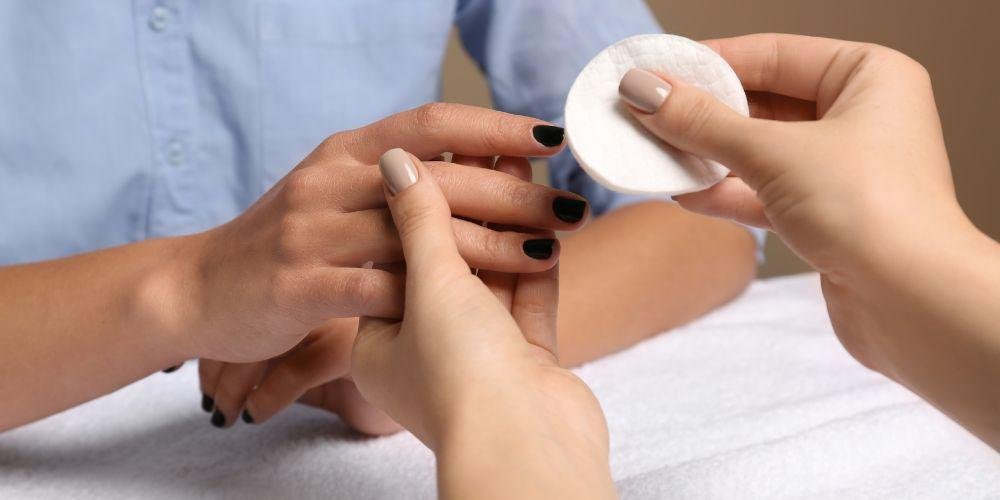Acetone is one of the common ingredients in many nail polish removers because of its powerful ability to dissolve and break down nail polish quickly. While acetone-based removers can effectively remove stubborn nail varnish, they also have some potential risks and drawbacks that nail users should be aware of. In this comprehensive blog, we’ll explore the main dangers and problems arising from using acetone-based nail polish remover so you can make a more informed decision about the best way to remove nails and how to keep them healthy.
What is acetone?
Acetone is a powerful solvent whose chemical properties make it very effective at breaking down substances such as nail polish. It is commonly found in many household products. However, its primary use in personal care is a nail polish remover. Despite its popularity, acetone’s harsh properties can negatively affect your nails and overall health.
Direct effects on nails and skin
One of the most significant direct effects of acetone is its drying properties. Acetone strips nails of natural oils, leading to dryness and potential brittleness. This weakens the nails, making them more likely to split and flake. In addition, acetone can cause irritation and dryness of the surrounding skin, leading to discomfort and potential skin problems.
The drying effect of acetone
One of the main problems with using an acetone-based nail polish remover is the extremely dry and dehydrating effect it can have on the nails and surrounding skin. Acetone is a very effective solvent that not only dissolves nail polish but also removes natural oils and moisture from nails, cuticles, and the skin on your hands.
This can lead to a range of problems, including brittle, cracked, and flaking nails, dry, flaky, and inflamed cuticles, and skin around the nail. Acetone’s drying effects can be particularly problematic for people who are already struggling with dry, fragile nails or hands prone to eczema.

Increased risk of nail fungus
Another significant risk factor of using acetone removers is an increased susceptibility to developing nail fungal infections. Acetone strips nails of their protective layer, making them more vulnerable to fungal spores, leading to unsightly and hard-to-treat onychomycosis.
Nail fungi thrive in warm, moist environments, and the drying effect of acetone can create the perfect conditions for fungal growth by weakening nail structure and compromising its natural defenses. Once nail fungus takes hold, eradicating it is challenging and often requires prolonged treatment with prescribed antifungal drugs.
Potential skin irritation and allergic reactions
For some people, the intense volatility of acetone can also cause skin irritation and allergic reactions. This compound can cause skin redness, tingling, burning, and even peeling or flaking, especially for sensitive skin types.
In more severe cases, acetone exposure may trigger an allergic reaction, causing hives, swelling, and even allergic reactions in people who are sensitive to acetone. This is particularly concerning for nail technicians and salon workers, who are often exposed to acetone-containing removers.
Weakening of nails
Over time, frequent use of acetone-containing nail polish remover can also cause nails to become thinner, weaker, and brittle. Acetone’s drying effect not only affects the nail surface but also penetrates deep into the nail bed, damaging the overall structure and integrity of the nail.
This can cause nails to split, flake, crack, or break easily, which is both unsightly and uncomfortable. Repeated exposure to acetone gradually wears down nails, making them more prone to damage and deformation.
Alternative to acetone-based removers
Fortunately, many practical and safer alternatives can help you remove nail varnish without the same risks and drawbacks. Some of the most popular options include:
Non-acetone removers: These nail polish removers use alternative solvents such as ethyl acetate or isopropyl alcohol to break down and dissolve nail polish. Although they may take longer to take effect, they are generally not too dry and do not cause harm to nails and skin.

Soy-based nail polish remover: Soy-based nail polish removers take advantage of soybeans’ natural dissolving properties to remove nail polish in a gentler, more nourishing way. They tend to be less harsh and stimulating than acetone-based options.
Nail polish remover pads: These pre-soaked pads offer a convenient and controlled way to remove nail polish, eliminating the need to handle liquid acetone. They are often infused with moisturizing ingredients, providing a dual benefit of convenience and nail care.
Gel nail polish remover: To remove gel nails, specialized gel nail polish remover contains conditioning ingredients that do not contain acetone. It may be a better choice than standard acetone nail polish remover, which may have an excessively corrosive effect on nails.
By exploring these alternative nail polish removal methods, you can enjoy the convenience of removing nail polish while minimizing the risks and drawbacks of acetone products. Your nails will thank you. Contact Best Nail Salon Mesa to learn more about these nail remover options.
While acetone removers are highly effective, they come with significant risks to your nail health and overall well-being. Understanding these risks is crucial in making informed decisions about your nail care routine. Consider exploring gentler alternatives and adopting safer application methods to protect your nails and skin. Prioritizing the health of your nails can make them stronger and more resilient, enhancing your overall nail care experience.





